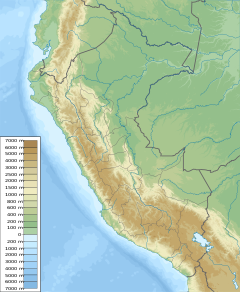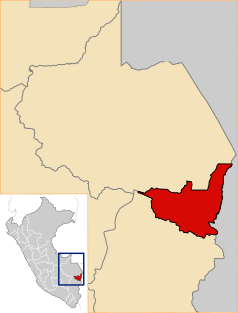Bahuaja Sonene National Park
| Bahuaja Sonene National Park | ||
|---|---|---|
|
|
||
| Location: | Madre de Dios , Puno , Peru | |
| Next city: | Puerto Maldonado | |
| Surface: | 10914.16 km² | |
| Founding: | July 19, 1996 | |
| Map of the Bahuaja Sonene National Park (red) | ||
The Bahuaja Sonene National Park (Spanish: Parque Nacional Bahuaja-Sonene ) is a national park founded on July 19, 1996 by decree N ° 012-96-AG in the Tambopata Province in the Madre de Dios region and in the Carabaya and Sandia provinces in the region of Puno in Peru . The park was expanded by decree Nº 048-2000-AG of September 5, 2000.
location
The aim of the park is to preserve a mosaic of different habitats , which combine many elements of the biodiversity of the southern and northern Amazon. The park protects unique areas of Peru, such as the humid tropical savannah Pampas del Heath on the Río Heath and the formations of the Candamo Valley in the Selva de Candamo. The indigenous minority of the Ese-eja Indians live in the park , whose cultural characteristics are also protected. The ecoregion with the Amazon rainforest serves as a typical habitat with tropical forest and mountain rainforest. The area has lakes or lagoons, palm swamps, and seasonally flooded areas. In 1983 the Pampas del Heath was declared a protected area. From December to April the flat pastureland, which is criss-crossed by small groups of palm trees up to 2 meters high, is flooded so that the palm trees form small islands. It forms the southern border of the tropical forests and then merges into the Benish flood savannah of the Moxos plain . Much of the area now belongs to the Ese-eja ethnic group from the Tacana language family , which is now concentrated in the communities of Infierno , Palma Real and Sonene right on the edge of the park. A fourth community called Kotsimba belongs to the Pukirieri ethnic group .
Flora and fauna
The park has a remarkable biodiversity.
Mammals
Among the at least 180 species of mammals there are a. the bush dog ( Speothos venaticus ), the crab-eating fox ( Cerdocyon thous ), the short-eared dog ( Atelocynus Microtis ), the giant otter ( Pteronura brasiliensis ), the sump Hirsch ( Blastocerus dichotomus ), the mane Wolf ( Chrysocyon brachyurus ), the Large Ameisenbär ( Myrmecophaga tridactyla ) the giant armadillo ( Priodontes maximus ), the black- faced spider monkey ( Ateles chamek ) and the jaguar ( Panthera onca ). In 2012 the bat species Trinycteris nicefori and Eastern Pipistrelle ( Pipistrellus subflavus ) were detected in the park for the first time .
Birds
At least 600 species of birds are known in the park, with around 376 occurring on the Río Heath. So live here u. a. Schwarztinamu ( Tinamus osgoodi ) Rotkehltinamu ( Crypturellus strigulosus ) Schwarzkappentinamu ( Crypturellus atrocapillus ), Orinoco Goose ( Neochen jubata ), harpies ( Harpia harpyja ), White brewing Bussard ( Leucopternis kuhli ) Würgadler ( Morphnus guianensis ), White Wing Trompetervogel ( Psophia leucoptera ) rust cap parrot ( Pionites leucogaster ), Blue headed Macaw ( Primolius couloni ), Black cap parakeet ( Pyrrhura rupicola ), Amazon parrot ( Nannopsittaca dachilleae ), Orange Hermit ( Phaethornis philippii ) Curl-Crested Aracari ( Pteroglossus beauharnaesii ) Goldstirn-piculet ( Picumnus aurifrons ) Weißkehl-jacamar ( Brachygalba albogularis ) Blaustirn-jacamar ( Galbula Cyanescens ), half-ring-Faulvogel ( Malacoptila semicincta ), Western Gelbbauchpipra ( Neopelma sulphureiventer ) Yungaspipra ( Chiroxiphia boliviana ) Schwarzkopfpipra ( Heterocercus linteatus ) strip breast Todityrann ( Hemitriccus flammulatus ), white-bellied Schuppenkopftyr ann ( Lophotriccus eulophotes ), White-Todityrann ( Poecilotriccus albifacies ), bamboo Ameisenwürger ( Cymbilaimus sanctaemariae ), Blue Gray Würger Ling ( Thamnomanes schistogynus ) Olivbrauner Antwren ( Epinecrophylla leucophthalma ), yellow striped Antwren ( Myrmotherula sclateri ) Iheringameisenschlüpfer ( Myrmotherula iheringi ) Manuameisenfänger ( Cercomacra manu ), Southern Grauameisenschnäpper ( Hypocnemoides maculicauda ), redhead-Ameisenvogel ( Myrmoborus lophotes ) Goeldiameisenvogel ( Akletos goeldii ) binding tail Ameisenvogel ( Gymnopithys salvini ), rust end-Ameisendrossel ( Formicarius rufifrons ) Olivmantel-Ameisenpitta ( Hylopezus berlepschi ), Stark beak -Blattspäher ( Syndactyla ucayalae ), rust vertex thicket panties ( Synallaxis cabanisi ), Schwarzkopf bunting ( Coryphaspiza melanotis ) Spiegeltangare ( Conothraupis speculigera ) Gelbschopftangare ( Tachyphonus rufiventer ), yellow end-Würgertangare ( Lanio versicolor ) and Schar Laughed Bearded Bird ( Eubucco tucinkae ). There are also seven species of the true macaw ( Ara sp.) , Roseate spoonbills ( Platalea ajaja ) and king vultures ( Sarcoramphus papa ) in the park. The thirty new bird species in the park that were discovered in a study in 2012 include: a. Magpie eagle ( Spizaetus melanoleucus ), Wilson's treadmill ( Steganopus tricolor ), gray-throated cuckoo ( Coccycua cinerea ).
Reptiles
Among the reptiles we find the black caiman ( Melanosuchus niger ), the green anaconda ( Eunectes murinus ) and the yellow-spotted river turtle ( Podocnemis unifilis ). The frogs in the park include a. Ameerega simulans and Phyllomedusa bicolor .
fishes
So far, at least 180 species of fish have been spotted in the park.
Butterflies
With 1200 species of butterflies, the biodiversity in the park is huge.
flora
Among the plants one can find the Buriti palm ( Mauritia flexuosa ), Hevea guianensis and Cedrelinga cateniformis , West Indian cedar ( Cedrela odorata ), American mahogany ( Swietenia macrophylla ), Brazil nut tree ( Bertholletia excelsa ) and various palms such as Iriartea deltoidea , udder palm . or Oenocarpus bataua .
climate
The park is at the interface between humid tropical and subtropical Amazon climates. The average annual precipitation is equivalent to 2,400 mm. The average temperature is 30 ° C. In summer up to 38 ° C can be reached. Occasionally the temperature drops to 8 ° C. Antarctic winds then penetrate the park, which ultimately lead to low temperatures in June and July. With the rainy season from December to March, the plains are covered with water, resulting in a huge swamp formation.
Individual evidence
- ↑ DECRETO SUPREMO Nº 0800-75-AG - Parque Nacional Cerros de Amotape (Spanish)
- ↑ DECRETO SUPREMO Nº 048-2000-AG - Reserva Nacional Tambopata (Spanish)
- ↑ a b c d e f g h Bahuaja Sonene near Sernap
- ↑ a b c Nature's Surprise: 365 New Species Spotted in Peru
- ↑ BirdLife Important Bird and Biodiversity Areas - Bahuaja-Sonene

